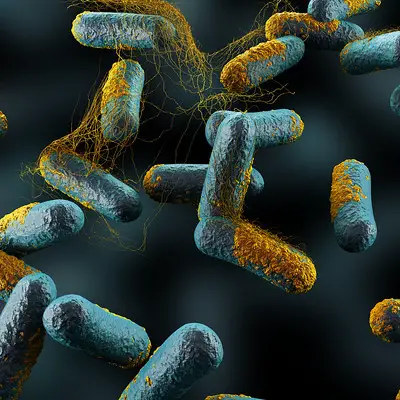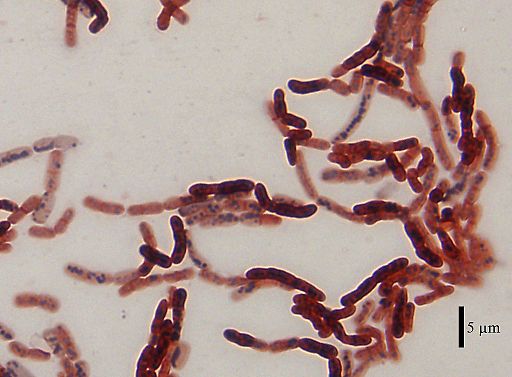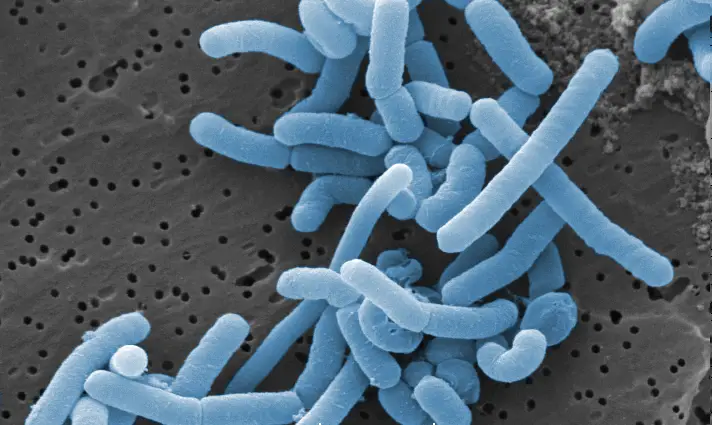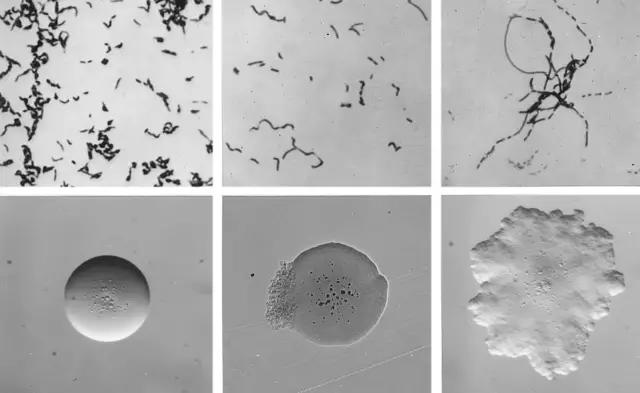Phylum Firmicutes
** Function and Characteristics
Overview
Phylum Firmicutes is made up of Gram-positive bacteria many of which are part of the normal flora. However, they can also be found in various environments as free-living prokaryotes or as parasites.
Currently, the phylum is estimated to consist of over 250 genera divided into three main classes that include:
Clostridia (Genera; Pectinatus, Sporomusa, and Acetobacterium, etc.)
Bacilli (Genera: Lactococcus, Listeria, and Pediococcus, etc.)
Mollicutes (Genera: Mycoplasma, Ureaplasma, and Spiroplasma, etc.)
* Some taxonomic systems consist of seven major classes that include; Limnochordia, Erysipelotrichia, Negativicutes, Clostridia, Bacilli, Tissierellia, and Thermolithobacteria.
Phylum Firmicutes: Characteristics of Class Clostridia
Clostridia is a large group of ancient spore-forming anaerobic bacteria that are widely distributed around the world.
Some examples of species in this group include:
- Clostridium Difficile
- Clostridium botulinum
- Clostridium tetani
- Clostridium Perfringens
- Clostridium novyi
- Clostridium septicum
See more information about Clostridium.
Morphology and Structural Characteristics
The majority of species in the class Clostridia are Gram-positive bacteria. As such, they are characterized by a thick peptidoglycan layer that allows them to retain the primary stain during Gram staining. In addition to the peptidoglycan layer, some species have an additional protective layer in their cell membrane.
In some members of the genus Clostridium, for instance (Clostridium difficile), studies have reported a surface layer (S-layer) around the peptidoglycan layer. Composed of S-layer protein, this layer plays a key role in disease.
While the majority of Clostridia species are Gram-positive (at least at some point during growth), some may appear Gram-negative or Gram-variable during staining. This may be as a result of low G+C content or simply due to prolonged incubation.
As well, species with terminal species may also appear Gram-negative or Gram-variable.
* The majority of Gram-positive Firmicutes can be found in the classes Clostridia and Bacilli.
Most of the species are characterized by a rod-shaped morphology (straight or slightly curved) with rounded or tapered ends. However, some are shorter than others and thus appear oval in shape. While some of the members are slightly curved, others, like H. pylori in the genus Heliobacter vary from curved to spiral in shape.
Depending on the species, these cells may be arranged in pairs or form short chains while others occur singly. For instance, some members of the genus Clostridium are arranged in short chains while others exist in pairs. As well, Pectinatus species may occur in pairs or singly and very rarely form short chains.
For many of these species, motility is made possible by the presence of flagella (or a single flagellum). Among members of the genus Pectinatus, flagella are produced on one end of the cells (polar flagella) while Acetobacterium moves by means of one or two sub-terminal flagella. Clostridium species like C. difficile have peritrichous flagella used for movement and adherence.
* Some species (e.g. some members of the genus Eubacterium) do not have flagella and are nonmotile.
As mentioned, some members of the class Clostridia are spore formers. Known as endospores, these spores vary in shape and size depending on the organism.
Clostridium species form oval, elongated (e.g. hexagonal structure of C. sordellii), or spherical spores characterized by multiple layers and a smooth surface. Similar spores are also produced by members of the genus Sporomusa under harsh environmental conditions that allow them to survive and germinate when conditions improve.
* Many other genera in this group do not form spores. These include Acetobacterium, Pectinatus, and Eubacterium, etc.
* Spore produced can survive for many years in the environment before they germinate under favorable conditions.
* Spores are resistant to various stressors including heat, UV light, detergents, and certain disinfectants, etc.
Habitat
Clostridia bacteria are widely spread and can be found in different environments across the world. They can be found in soil and dust, lakes and rivers, marine sediments, vegetation, and sewage. Given that many of these organisms are anaerobic, they normally reside in anoxic habitats.
Free-living Sporomusa and Clostridium species can be found in anoxic soils as well as river and lake habitats with very little oxygen concentration.
The following are some of the other habitats in which different types of Clostridia bacteria are found:
Pectinatus - Marine habitats, ponds, flooded canals, and the sublittoral zone.
Heliobacteria - Alkaline soils and soda lakes
Acetobacterium - Marine and ponds sediments
Other Clostridia can be found in various hosts as part of the normal flora or as parasites/pathogens. Various Clostridium can release toxins and cause diseases in human hosts.
In the intestine, the bacterium C difficile has been shown to release Toxin A which causes fluid accumulation which Clostridium tetani releases tetanospasmin and spasmogenic neurotoxin which cause cramps, muscle twitch, as well as spasms, etc. Many other Clostridium species are part of the normal biota in the gastrointestinal tract, mouth, and cervix/vaginal environments, etc.
* Some Clostridia like Heliobacteria are phototrophic and thus capable of photosynthetic energy conservation. Although they contain photosynthetic pigment bacteriochlorophyll g, they are incapable of autotrophic growth.
For this reason, they are reliant on organic carbon sources like most other bacteria in the group. They are therefore commonly referred to as photoheterotrophs and can be found in rice fields where they have access to a variety of organic compounds including lactate, butyrate, and pyruvate, etc.
Life Cycle
Clostridia species in phylum Firmicutes can use a wide variety of materials as a source of energy. In the soil and gut of various hosts, for instance, they have access to many organic substances that are fermented to produce energy (under anaerobic conditions).
For spore-forming species like Clostridium difficile, the life cycle goes through several stages that include:
Spore Formation
As mentioned, spore formation occurs under poor environmental conditions (e.g. when gut Clostridium species are released into the environment). Here, the process may start with the division of the cell to form a forespore and a large mother cell. The forespore is then engulfed by the mother cell but is separated from the cytoplasm by septal membranes.
Two peptidoglycan layers are then formed along with primordial germ cell wall, cortex, and protein surface layers that surround the forespore. A spore consisting of a tough outer layer is eventually released when the mother cell undergoes lysis. In this state, some of the bacteria can survive for several years in harsh environmental conditions.
Germination - Under favorable conditions, e.g. when the spore finds its way to the host gastrointestinal tract where they have access to moisture, favorable temperature, bile acid, and nutrients, etc., the spores undergo the germination process and give rise to the vegetative form of the bacteria.
In the gut, studies have shown enzymes like the lytic enzyme to play a role in hydrolyzing the cortex which causes the cell wall and inner membrane around the spore to expand. Other processes like rehydration and metabolism stimulation promote germination where the protoplast of the spore is converted into a vegetative cell.
Class Bacilli
Like Clostridia bacteria, the majority of Bacilli are Gram-positive species. However, they also display variations in the G+C content.
Currently, the class is divided into two main orders that include:
- Bacillales
- Lactobacillales
Phylum Firmicutes: Characteristics of the Order Bacillales
Morphology and Structural Characteristics
As members of the class Bacilli, the majority of Bacillales are Gram-positive organisms. As such, they have a relatively thick peptidoglycan layer that retains the primary stain.
In species like Bacillus subtilis, components of the cell wall (teichuronic acids, peptidoglycan, and teichoic acid) have been shown to contribute to its rigidity which in turn influence the general shape of the organism.
During Gram-staining, some of the species may appear gram-variable or Gram-negative. This has largely been attributed to the variation in the G+C content.
Here, species with low G+C content are more likely to appear Gram-variable or Gram-negative.
With regard to morphology, members of this group exhibit some variation in shape and size. For instance, while members of the genus Listeria are short rods (ranging between 0.5 to 2 um in length), the majority of Staphylococcus bacteria are spherical cocci (ranging between 0.5 and 1.5 um in diameter) and Bacillus are medium size rods.
Depending on the species, they may occur singly, in pairs, or form short chains. Some of the species (e.g. Listeria species) move by means of flagella. Listeria bacteria have peritrichous flagella. Others like Staphylococcus are non-motile.
* Staphylococcus (S. aureus) form round and convex colonies.
* In nature, they often grow in grape-like clusters. However, they may also form short chains.
* Rod Bacilli also form colonies that vary in size, shape, and color depending on the species. For instance, the colonies of some Listeria species are gray or black in color with a diameter of between 1 and 3 mm.
Spores - The genus Bacillus is the only group in the Order Bacillales in which spores are produced.
In the event of unfavorable environmental conditions (diminished nutrients) species like Bacillus anthracis produce spores that can survive through these conditions for a long period of time. These spores are metabolically inactive and are characterized by concentric shells consisting of a peptidoglycan layer, a protein shell, and the outermost layer made of protein and glycoprotein.
Each of these components serves an important role in protecting the spore from harsh environmental conditions.
These include:
- Peptidoglycan layer - Promotes spore dormancy
- Protein shell - protects the spore from toxic molecules
- Protein/glycoprotein layer - mediates communication with the external environments allowing the cell to respond to conditions as they change
Habitat
Bacilli bacteria in phylum Firmicutes can be found in different habitats across the globe.
These include:
Listeria bacteria - found in soil, decaying plant matter, water, as well as human and animal gut
Bacillus - water and terrestrial environments, and the gastrointestinal tract of human beings and some animals (especially ruminants)
Staphylococcus - found on skin surfaces where they exist as commensals - As such, they do not naturally cause harm. Apart from the skin, they can be found in other parts of the body including the mouth, nostril, and genitals, etc. In the environment, they can also be found on the surface of various surfaces, soil, and water.
* The majority of species are facultative anaerobes. As such, they can switch between aerobic and anaerobic respiration.
Nutrition - Bacteria in the order Bacillales rely on a variety of organic compounds for energy. These range from sugars (e.g. sucrose, mannose, and lactose, etc.) and organic sulfur compounds among others.
Phylum Firmicutes: Characteristics of the Order Lactobacillales
The order Lactobacillales consists of a number of genera that include Streptococcus, Lactobacillus, Enterococcus, Pediococcus, and Leuconostoc, etc.
Morphology and Structural Characteristics
Members of the order Lactobacillales are examples from phylum Firmicutes with low G+C content (less than 50%). However, the majority of species in this group are still Gram-positive bacteria with a complex cell wall that retains the primary stain during Gram staining.
As with many other Gram-positive bacteria, the cell wall of these species consists of a peptidoglycan layer, teichoic acids, polysaccharides, involved in communication, adhesion, and virulence, etc., and various proteins involved in colonization and protection.
Depending on the species, they may be spherical, ovoid, or rod-shaped. For instance, the majority of Streptococcus and Enterococcus bacteria are characterized by a spherical/cocci shape while Leuconostoc are ovoid and Lactobacillus are rod-shaped.
They also display variations in arrangement, from diplococci and short chains among Enterococcus species to elongated chains among members of the genus Streptococcus.
* Some of the species (e.g. Lactobacillus agilis and Lactobacillus ruminis) move by means of flagella.
* The majority of Lactobacillales bacteria in phylum Firmicutes do not form spores.
Habitat
Lactobacillales can be found in different habitats across the globe.
These include:
· Lactobacillus - Farm products like milk and cheese, silage, some spoiled foods, human and animal hosts, and soil
· Lactococcus - Dairy products, grass, and plant material, and animal gastrointestinal tract
· Enterococcus - Gastrointestinal tract of many animals and human beings. A few species can be found in the soil and water
· Leuconostoc - Plant material/vegetables, dairy products, and various organic matter
· Pediococcus - Soil, plants, and dairy products
· Streptococcus - Animal and human hosts (in the gut, respiratory tract, and mouth, etc.), dairy products, contaminated water, and soil.
Nutrition/metabolism - The majority of species in this group are lactic acid bacteria. As such, they obtain energy by metabolizing sugars into lactic acid through a process known as fermentation. They can access these sugars from a variety of food sources including milk, vegetables, meats, and fruits, etc.
As facultative anaerobes (oxygen-tolerant anaerobes), some of these bacteria are also capable of using oxygen in metabolic activities. For instance, the species Lactobacillus casei and Lactobacillus plantarum are well capable of respiratory growth under both aerobic and anaerobic conditions.
Phylum Firmicutes: Class Mollicutes
Members of the class Mollicutes are some of the smallest bacteria in nature. Though the group was originally referred to as Mycoplasmas, Mycoplasma is now classified as one of the genera within this class.
Some of the other genera in this group include:
- Spiroplasma
- Mycoplasma
- Ureaplasma
- Erysipelothrix
* Mollicutes in phylum Firmicutes consist of more than 179 species.
Morphological and Structural Characteristics
Unlike most other bacteria, Mollicutes are unique in that they lack a cell wall. However, they have a plasmatic membrane that contains the cytoplasm and a few organelles within the cell.
Compared to other Firmicutes, they also have very low G+C content, ranging between 23 and 40 percent mol% depending on the species. Because they lack a cell wall, they have been shown to be very delicate with varying shapes ranging from pear to elongated helicoidal filament morphology.
While Spiroplasma species have a helical shape, Mycoplasmas are characterized by a filamentous morphology. While they also lack flagella, some of the species (e.g. some Mycoplasma and Spiroplasmas) have been shown to move on various surfaces through gliding and are capable of chemotactic activity. This has been attributed to the cellular cytoskeleton. In addition, some of the species have a special terminal attachment organelle that contributes to motility.
As mentioned, Mollicutes are some of the smallest bacteria in existence. Depending on the species, they may vary from 100 to 300 nm in length (E.g. Mycoplasma pneumoniae is between 0.1 to 0.2 um in width) with a very small genome ranging between 600 and 2500 kbp.
Habitat
Because they lack a cell wall and are therefore more delicate compared to other bacteria, Mollicutes species are commonly found in association with various hosts. Some of the most common hosts include human beings, insects, and other mammals. As well, some of the species like members of the family Mycoplasmataceae can be found in plant hosts.
Nutrition - As parasites, the majority of Mollicutes obtain nutrition from their hosts. For example, Mycoplasma species found in animal tissues. For example, in the respiratory and urogenital tract is access to a variety of nutrients available for host cells.
* Given that they do not have a cell wall, these organisms are also incapable of forming spores in the environment.
Functions
A number species in phylum Firmicutes are parasitic in nature and capable of causing diseases in human beings and animals. In human beings, for instance, Mycoplasma pneumoniae is responsible for infections of the respiratory system and chest cold/tracheobronchitis among children.
Listeria monocytogenes is responsible for the foodborne disease listeriosis while Enterococcus faecalis can cause a range of infections including cellulitis and endocarditis among others.
Some of the species in this phylum are useful and have important functions.
These include:
Part of normal microbiota in the gut - As mentioned, members of the phylum Firmicutes are some of the most dominant microbiota in the human gut. Here, they have been shown to play an important role in the breakdown of polysaccharides like starch and given fibers. This not only helps release extra energy from these sources but also produces substances like butyrate that promote good health of the colon.
Probiotic - Apart from gut Firmicutes, some of the species like Lactobacillus acidophilus help prevent vaginal infections by producing compounds like acetate and lactate among other substances that prevent the development and proliferation of other harmful pathogens.
Yogurt production - Yogurt is one of the most popular dairy products around the world. Some of the bacteria used for yogurt production include Lactobacillus bulgaricus and Streptococcus thermophilus which belong to the phylum Firmicutes.
The bacteria convert the lactose in milk into lactic acid through a process known as fermentation. This causes the milk to thicken (because of protein coagulation). The acid is also the cause of the tart taste in yogurt. Compared to fresh milk, yogurt is easier to digest given that the milk protein is partially broken down by the bacteria.
Bacteriology as a field of study
Bacterial Transformation, Conjugation
How do Bacteria cause Disease?
Bacteria - Size, Shape and Arrangement - Eubacteria
Gram positive and Gram negative bacteria
What does Phylum mean in Biology?
Return from phylum Firmicutes to MicroscopeMaster home
References
Eugene Rosenberg. (2014). The Prokaryotes. Firmicutes and Tenericutes.
Eder Orlando Méndez-Salazar et al. (2018). Altered Gut Microbiota and Compositional Changes in Firmicutes and Proteobacteria in Mexican Undernourished and Obese Children.
José Antonio Rivera-Tapia, María Lilia Cedillo-Ramírez and Constantino Gil Juárez. (2002). Some biological features of Mollicutes.
Marie-Pierre Chapot-Chartier and Saulius Kulakauskas. (2014). Cell wall structure and function in lactic acid bacteria.
Links
https://www.bionity.com/en/encyclopedia/Firmicutes.html
https://micro.cornell.edu/research/epulopiscium/low-g-and-c-gram-positive-bacteria/
Find out how to advertise on MicroscopeMaster!








